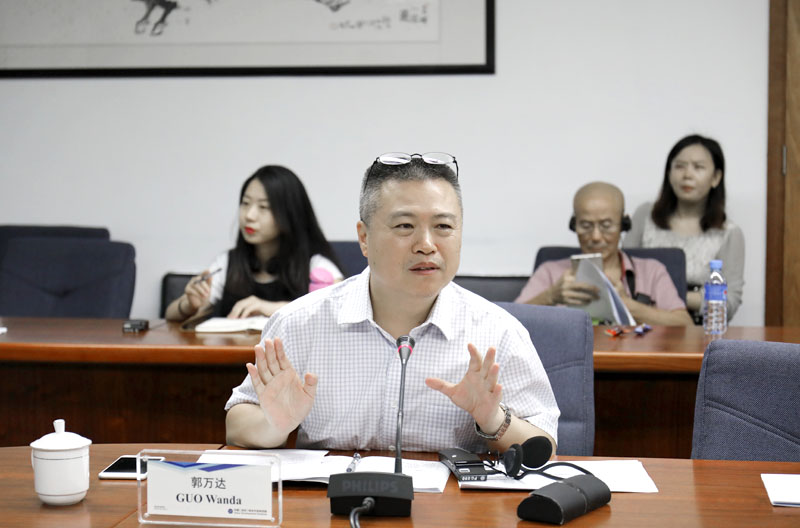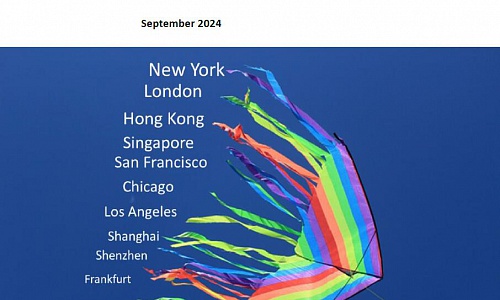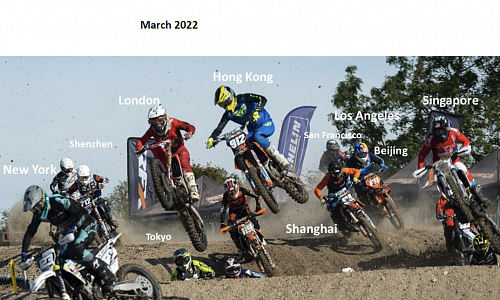Pacific Islands Forum Leaders Meeting Official Side-Event
Date: September 8, 2017 Venue: Sheraton Aggie Grey’s Hotel, Apia, SAMOA Host: CDI Theme: The 21st Century Maritime Silk Road: Pacific Islands-China Economic Cooperation for Sustainable Development
Information

China 's Urbanization and Consumption Transformation
 Author: Fan Gang, President, CDI
Author: Fan Gang, President, CDI
Editor’s Note: China’s low levels of consumption can be partly explained by the fact that consumption accounts for a rather small share of income, with China’s current household spending representing only 40% of GDP and the combined spending of government and consumers accounting for only 55% of GDP, and partly by high savings rate. In 2007, the national savings rate reached a record high of 51%. In recent years, despite efforts to reduce the proportion of savings and increase consumption, the national savings rate remains elevated at around 45%. Aside from household savings, corporate savings and government savings also matter. Corporate savings usually refer to profits that are not spent. Deposits of some large SOEs may total up to tens of billions of yuan, and yet they choose to save them with the SASAC (State-owned Assets Supervision and Administration Commission) rather than share the dividends or turn them over to the national treasury. Therefore, over the past decade, money has added up in bank accounts. And one motive behind the Belt and Road Initiative is to tackle high savings rate. China’s consumption is actually suppressed against such backdrop.
Drivers for Consumption Growth
Income growth is the most important driver for consumption growth. Countries with high consumption must also be high income countries. China is still a middle-income country with per capita GDP of 8000 dollars, while the per capita GDP of the United States is over 50,000 dollars, and that of Norway is 100,000 dollars, which ranks 1st in the world. As a developing country, China’s consumption surely needs to become stronger. An increase in earnings among people with lower income, who demonstrate higher elasticity of consumer demand, will contribute to faster consumption growth of the society as a whole.
Credit consumption and finance are also driving forces behind consumption growth, which have seen rapid growth with the development of P2P platforms and Internet finance. Online mobile phone purchased by university students constitutes a short-term small consumer credit. China's consumer credit has surpassed industrial loans to become the largest sector in the banking system with 26% of share.
E-commerce has also fueled consumer spending. Presently, delivery reaches not only urban areas but also the countryside. These delivery vehicles are loaded with consumer goods.
Patterns of Consumption Growth
First, though the Chinese appetite for material consumption is far from been satisfied, service consumption has begun to grow. With growing income, people begin to have more disposable income to spend, with the consumption of physical goods seeing the fastest grow that the moment. Meanwhile, service consumption has begun to see substantial growth as well. The service industry has become the largest industry in China today. Transformation from diversified consumption to the service industry is taking place and gaining momentum.
Second, traditional consumption and new types of consumption are both on the rise. Basic needs such as those for housing and family life have not been met. 70% of the Chinese are the low-income class, of whom 34% are farmers. As their income grows, many of them will first try to meet their basic needs, thus generating great market potential in traditional consumption. An important driving force behind this process is urbanization, which obviously is related to the property market. As people migrate, their housing needs change accordingly. Farmers want to buy houses in the county as they move in from the countryside. County residents prefer to live in prefecture-level cities, as those in prefecture-level cities seek personal development in provincial capitals, whose residents decide to try their fortunes in megacities. As the country urbanizes, its people are moving from one house to another.
In a way similar to housing, the consumer market follows where people move. During the urbanization process, new types of consumption, such as consumption of entertainment, culture, health and education are also growing faster and the share of the service industry will be even larger. According to the big data provided by international credit card companies, the growth of high-end service industry is the future trend, while the consumption of goods will be more diversified, refined, functional and ritualized, which will inevitably create a lot of demand, such as people’s demand for professional sportswear.
Finally, it is worth noting that China's retirement consumption has just begun. With an aging population, there is still a long time between retirement and old age requiring elderly care. Perhaps people will begin to need elderly care only in their 80s. If they are 60 years old now, there will still be 20 years ahead to enjoy and to consume before old age. China’s new-generation retirees are just emerging, who, benefiting from high economic growth brought by reform and opening-up over the past 30 years, have become China’s middle class. Before retirement, many of them have money but little leisure time, but now as they have both, the party of retirement consumption will begin.
Hong Kong Financing Platform Facilitates Overseas Economic and Trade Cooperation Zones
 Author: Qu Jian, Vice President, CDI
Author: Qu Jian, Vice President, CDI
Editor’s Note: Overseas economic and trade cooperation zones have become important vehicles and platforms for Chinese mainland companies investing oversea and building relationship with foreign partners. Hong Kong's strength as an international finance center with an open market in the scope of specialized services, from financial investment to logistics and shipping, capital construction management, legal arbitration, and to regional businesses, has played a massive role in the investment and construction of "The Belt and Road" overseas industrial parks.
First of all, most of the capital for the expansion of overseas industrial parks is raised from the market. Hong Kong can provide professional services like complete specialized project valuation and sustainable development estimate for Chinese mainland companies investing in the countries along the B&R to introduce external funds and finance overseas investment projects or other businesses. What’s more, the service platforms in Hong Kong can offer mainland companies a multitude of investment ways, such as, private equity investment funds, equity joint investment, or other joint stock cooperation, thereby enabling them to spread risk.
For another, the construction of overseas economic and trade cooperation zones has accelerated the industrialization and driven related industries and economic development of the host countries along the OBOR. In addition, the successful experiences of the Shenzhen Special Economic Zone and the Hong Kong institutional system can further help host nations to establish special economic zones. The establishment of industrial parks abroad needs one statute, two plans (industrial planning and spatial layout planning), three schemes (business scheme, financing scheme, management and operation scheme). The returns on financing and investment that involve with these three aspects above highly coincide with the financial industrial of Hong Kong. Given that Hong Kong’s financial industrial offers financial services for Chinese investors to explore the markets in laggard developing countries along the B&R, it will tremendously spur the economy of these countries and encourage more enterprises from Chinese mainland to invest abroad.
CDI Delegation Attends Singapore Roundtable on China – India Economic Integration
 President of CDI, Pro. Fan Gang and Postdoctoral Researcher, Zhang Guoping attended roundtable on China-India Economic Integration jointly hosted by the CDI, Center for Policy Research and Mastercard Center for Inclusive Growth in Singapore, from September 11 to 14. The roundtable aims to explore the feasibility of furthering closer economic integration between China and India under current conditions of bilateral relations.
President of CDI, Pro. Fan Gang and Postdoctoral Researcher, Zhang Guoping attended roundtable on China-India Economic Integration jointly hosted by the CDI, Center for Policy Research and Mastercard Center for Inclusive Growth in Singapore, from September 11 to 14. The roundtable aims to explore the feasibility of furthering closer economic integration between China and India under current conditions of bilateral relations.
President Fan and the representatives of Center for Policy Research and Mastercard Center conducted a sound discussion on the formulation of an effective modality of operating joint research with the purpose of accelerating China-India economic and trade cooperation and promoting other relevant mutually beneficial relationship. During the roundtable, CDI and CPR delegation clarified the framework for pilot joint research and identified the key issue, such as inclusive growth, employment, micro entrepreneurship and productivity, and urban planning.
Dr. Guo Wanda Attends Singapore and Hong Kong: Comparative Perspective on the Occasion of the 20th Anniversary of the Handover
 Executive Vice President, Dr. Guo Wanda, attended the “Singapore and Hong Kong: Comparative Perspective on the Occasion of the 20th Anniversary of the Handover” workshop held by the Institute of Advanced Studies, NTU, the Nanyang Centre for Public Administration, NTU, and the Hong Kong Singapore Business Association in Singapore on September 4. Dr. Guo Wanda spoke on “Shenzhen - Hong Kong: Review and Outlook” through analyzing Shenzhen and Hong Kong’s past economic development, e.g. “stores in front, factories in back” model, and the prosperity of Guangdong – Hong Kong – Macau Greater Bay Area and Shenzhen – Hong Kong Metropolis.
Executive Vice President, Dr. Guo Wanda, attended the “Singapore and Hong Kong: Comparative Perspective on the Occasion of the 20th Anniversary of the Handover” workshop held by the Institute of Advanced Studies, NTU, the Nanyang Centre for Public Administration, NTU, and the Hong Kong Singapore Business Association in Singapore on September 4. Dr. Guo Wanda spoke on “Shenzhen - Hong Kong: Review and Outlook” through analyzing Shenzhen and Hong Kong’s past economic development, e.g. “stores in front, factories in back” model, and the prosperity of Guangdong – Hong Kong – Macau Greater Bay Area and Shenzhen – Hong Kong Metropolis.
The Global Financial Centres Index 22 Launch
Information

Date: September 11, 2017
Venue: Tianfu Fund Town, Chengdu
Host: CDI, Z/Yen Group
Theme: The Global Financial Centres Index 22
The Global Financial Centres Index 22 (GFCI 22)
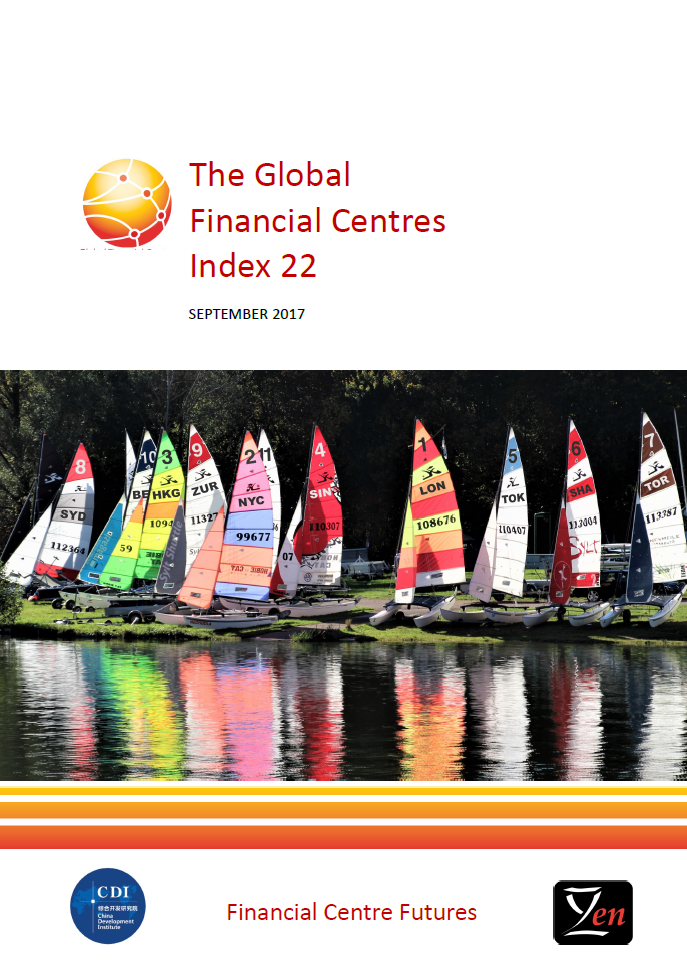 Click here to download the full report as PDF.
Click here to download the full report as PDF.
London and New York remain in first and second places. Interestingly, despite the ongoing Brexit negotiations, London only fell two points, the smallest decline in the top ten centres. Hong Kong has moved just ahead of Singapore into third – only two points ahead on a scale of 1,000. Tokyo remains in fifth.
There are seven cities across the Chinese mainland rated in the GFCI 22, namely Shanghai, Beijing, Shenzhen, Guangzhou, Qingdao, Dalian and the newcomer Chengdu. Among them, Shanghai got 711 points and ranks 6th, rising 7 places in the rankings. Beijing rose 6 places to the 10th position. Shenzhen got 689 points and ranks 20th, rising 2 places. Shanghai, Beijing ,and Shenzhen are in the top 20 financial centres. Guangzhou ranks 32nd and Qingdao ranks 47th. Chengdu, first enlisted in the GFCI rankings from the associate centres list, ranks 86th and got 604 points. Dalian fell to 92nd.
GFCI 22, jointly compiled by Z/Yen and Group CDI, was launched simultaneously in Chengdu, China and Abu Dhabi, The United Arab Emirates.
Managing Financial Outflows with Cautions
 Growth remained generally stable in July. Industrial output was up 6.4% y/y, similar to previous months. But fixed asset investment, the key growth driver, climbed only 6.8% y/y in real terms, its lowest rate this year, and was down 1.5 pps from Q2. Its adjusted growth rate is less than 5%, which will pressure future growth.
Growth remained generally stable in July. Industrial output was up 6.4% y/y, similar to previous months. But fixed asset investment, the key growth driver, climbed only 6.8% y/y in real terms, its lowest rate this year, and was down 1.5 pps from Q2. Its adjusted growth rate is less than 5%, which will pressure future growth.
Real estate investment was hit by real estate market cooling, and was up just 4.7% y/y in July, down 3.4 pps from Q2. Imports were up 11% y/yy, down 3.2 pps. Import growth may even turn negative next year. Exports were up 7.2% y/y, down 2 pps from Q2. Retail sales of consumer goods have historically been less volatile, and were up 9.6% y/y in real terms in July, same rate as in June. CPI was slightly lower, up 1.4% y/y. But there are strong signs that vegetable, egg and pork prices will rebound, and CPI may rise to 2%. Producer price rises continued to slow. In July, ex-factory production prices rose 5.5% y/y, while PPI rose 7% y/y, down 0.3 pps from June.
Monetary policy in July continued falling back toward normal levels. M2 was up 9.2% y/y, down 2.1 pps from the end of 2016. M1 rose 15.3% y/y. Financial institutions’ estimated shadow banking investment increased 8.65 trillion yuan in 2016 alone, but decreased 845 billion yuan in Q2.
The National Financial Work Conference in July singled out prevention of financial risks as a top priority, including risks from outgoing investment. Chinese overseas M&A has often made major newspaper headlines in recent years, especially in 2016. After an August 18th session of the conference, the State Council gave detailed instructions about sectors where direct investment should be more restricted, and encouraged Chinese companies with M&A linked to real estate, hotels and entertainment, to be more cautious. This may reduce or even stop currently highly-leveraged corporations from investing. This initiative shows the government’s determination to rein in risk, and should prevent systemic financial risk.
CDI International Report on Rethinking on RMB Internationalization
Information
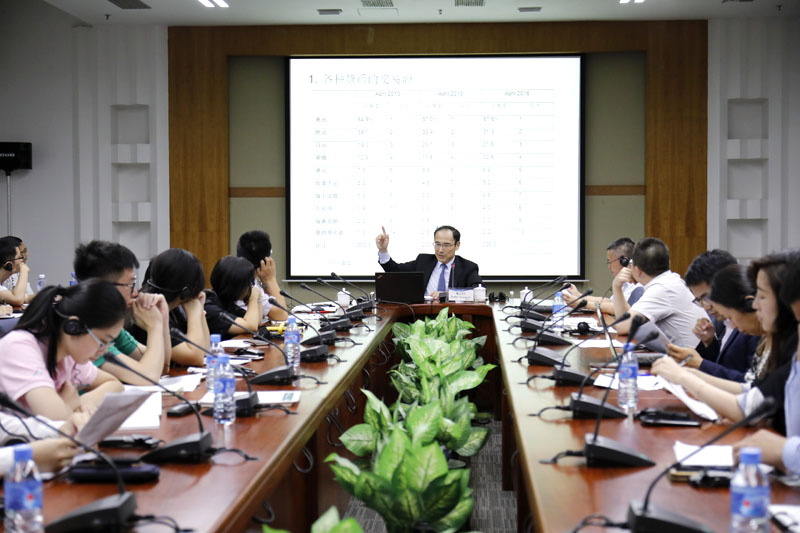 CDI invited Professor Yosuke Tsuyuguchi from the College of Economics, Nihon University to share the experience of Yen’s internationalization, including the gains and losses in the internationalization process and how the process is relevant to RMB internationalization.
CDI invited Professor Yosuke Tsuyuguchi from the College of Economics, Nihon University to share the experience of Yen’s internationalization, including the gains and losses in the internationalization process and how the process is relevant to RMB internationalization.
Date: August 25, 2017
Venue: Room 101, CDI Mansion, Shenzhen
Host: CDI
Theme: Rethinking RMB Internationalization: Why is Japan so Prudent about Yen’s Internationalization?
CDI Delegation Attends 2017 GRI International Conference



